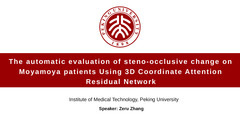报告详情
The automatic evaluation of steno-occlusive change on Moyamoya patients Using 3D Coordinate Attention Residual Networks
编号:60
访问权限:仅限参会人
更新:2021-10-30 18:36:15 浏览:1489次
口头报告
摘要
Moyamoya is a specific chronic cerebrovascular occlusive disorder that is characterized by progressive bilateral stenosis of the terminal portion of the internal carotid artery and its main branches. The surgical procedure of intracranial and extracranial vascular reconstruction can reduce symptoms and lower the risk of complication. The surgery threshold depends on the preoperative brain vascular imaging evaluation whose accuracy is greatly influenced by the radiologist. This study aims to achieve a preoperative deep learning-based evaluation of moyamoya patients by distinguishing between stenosis and normal MCA. The deep learning model with fine-tuning was developed using 3D Coordinate Attention Residual Networks (CA-ResNet). A total of 50 patients with moyamoya disease and 50 normal controls were enrolled. The preoperative Time-of-Flight Magnetic Resonance Angiography (TOF-MRA) was performed in all patients. For each patient, a region with 60mm thickness was extracted based on the reference points on MCA. The 3D CA-ResNet was trained based on sub-volumes  patches from selected regions and was tested using patch-based and patient-based methods. The performance of 3D CA-ResNet was compared with those of conventional networks including 3D ResNet and 3D Visual Geometry Group (VGG), where the Area Under the Curve (AUC) and classification accuracy were used as evaluation indicators. The final experiments showed the expected results in distinguishing between patients with moyamoya disease and normal controls. Specifically, the values of AUC and accuracy were 0.94 and 0.89 for patch-based and only one patient was misdiagnosed for patient-based testing in 3D CA-ResNet, respectively. In addition, the AUC value of 3D CA-ResNet was higher than the counterparts of conventional 3D ResNet or 3D VGG for patch-based testing (3D CA-ResNet: 0.94 vs. 3D ResNet: 0.85; 3D CA-ResNet: 0.94 vs. 3D VGG: 0.84). Besides, Gradient-weighted Class Activation Mapping based on heatmap was used to provide visual clues related to vascular stenosis location on MCA. The results indicated that all the three models above are able to differentially diagnose moyamoya disease from clinical TOF-MRA data, and the 3D CA-ResNet outperforms 3D ResNet and 3D VGG in evaluating vascular steno-occlusive change on moyamoya patients.
patches from selected regions and was tested using patch-based and patient-based methods. The performance of 3D CA-ResNet was compared with those of conventional networks including 3D ResNet and 3D Visual Geometry Group (VGG), where the Area Under the Curve (AUC) and classification accuracy were used as evaluation indicators. The final experiments showed the expected results in distinguishing between patients with moyamoya disease and normal controls. Specifically, the values of AUC and accuracy were 0.94 and 0.89 for patch-based and only one patient was misdiagnosed for patient-based testing in 3D CA-ResNet, respectively. In addition, the AUC value of 3D CA-ResNet was higher than the counterparts of conventional 3D ResNet or 3D VGG for patch-based testing (3D CA-ResNet: 0.94 vs. 3D ResNet: 0.85; 3D CA-ResNet: 0.94 vs. 3D VGG: 0.84). Besides, Gradient-weighted Class Activation Mapping based on heatmap was used to provide visual clues related to vascular stenosis location on MCA. The results indicated that all the three models above are able to differentially diagnose moyamoya disease from clinical TOF-MRA data, and the 3D CA-ResNet outperforms 3D ResNet and 3D VGG in evaluating vascular steno-occlusive change on moyamoya patients.
关键词
Moyamoya,Convolution neural network; Deep learning; Image classification,cerebrovascular stenosis
报告人

泽茹 张
无 北京大学Master student major in medical imaging technique of Peking University
稿件作者
全部评论
重要日期
-
会议日期
11月13日
2021
至11月14日
2021
-
09月30日 2021
报告提交截止日期
-
11月14日 2021
注册截止日期
主办单位
IEEE北京分会
中国生物医学工程学会医学物理分会
中国电子学会生命电子学分会
中国生物医学工程学会医学物理分会
中国电子学会生命电子学分会
承办单位
中国科学技术大学
安徽省生物医学工程学会
安徽省生物医学工程学会
联系方式
- Mrs. Yang
- ic******@ustc.edu.cn
- +86********
历届会议
-
2017年11月04日 中国 Beijing,China
2017 International Conference on Medical Imaging Physics and Engineering -
2017年11月03日 中国 海淀区
2017 IEEE 国际医学影像物理和工程大会 -
2013年10月19日 中国 沈阳市
2013 IEEE国际医学影像物理和工程大会暨第七届中国医学影像物理学术年会



发表评论